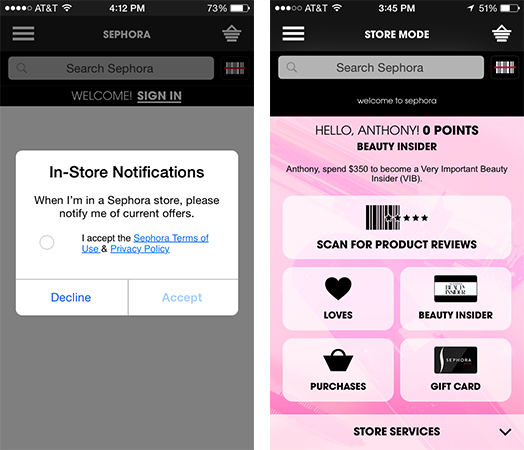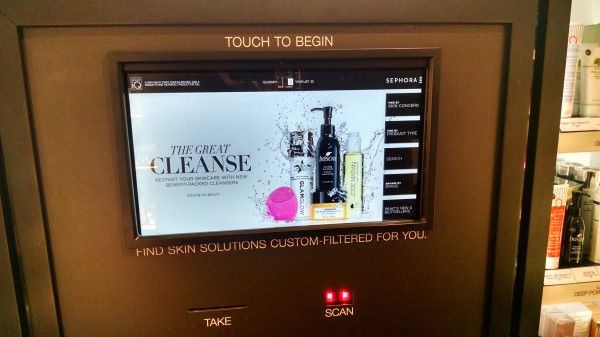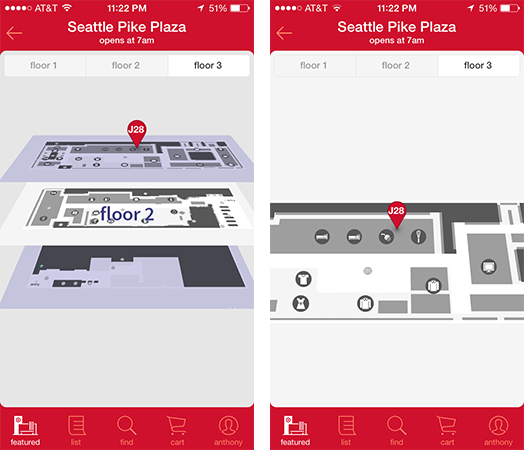Beacon Of Hope: Pushing Mobile Technology
Though beacon technology is still in its early stages, columnist Anthony Bursi believes that this form of customized, personalized marketing has the potential to revolutionize retail.
Beacon technology has been in the news for its potential to revolutionize the retail industry and bridge the gap between mobile technology and brick-and-mortar sales. With iBeacons and push notifications being all the rage, I wanted to test this experience firsthand, especially after Safeway announced it was deploying beacons in select Seattle stores.
What followed, as I describe below, was slight disappointment but overall optimism for this fledgling technology.
The Skinny On Beacons
First, a little background on beacons and how they work. Beacons are low-powered radio transmitters that use Bluetooth technology to monitor the proximity of mobile devices. When a smartphone is near the beacon and has the retailer’s app enabled, the beacon can trigger push notifications that promote special offers and useful content directly to the device.
This kind of hyper-local connectivity makes retailers salivate. And why not? The market is primed for this type of engagement. According to a Swirl study, 80% of customers are more likely to engage with retailer apps while shopping if they receive notifications on deals and discounts. Furthermore, 62% of respondents will engage if the content is customized to their likes and preferences.
Locating statistics on the prevalence of beacons in stores has been difficult, but it appears that many retailers are open to experimenting with this technology.
Sephora
In March 2015, Sephora launched a beacon trial in their San Francisco store, during which they discovered that 82% of customers opted in to receive messages.
I downloaded the Sephora app, enabled in-store notifications, and visited a Downtown Seattle location to see if there was a chance they shipped a few beacons to the Pacific Northwest.

Sephora In-Store Notification & App
Alas, I failed to receive any onsite notifications. By the third time I was asked if I needed any help, I copped to my ulterior motive.
The nice but seemingly confused representative directed me to their Skin IQ station, an interactive touchscreen that identifies what skin products are right for you.

Sephora Skin IQ Station
Although it wasn’t what I was looking for, it got me thinking about how this digital station is the precursor to advanced mobile engagement. Instead of using the station to watch videos, scan barcodes for more information, and read product reviews on the big screen, customers can freely move about the store while simultaneously interacting with beacons on their phones.
According to Swirl, 65% of 1,000 surveyed smartphone owners would rather learn of a promotion from their phone over a sales associate. Furthermore, 79% of users who read or opened shopping-related push notifications made a purchase.
By investing in beacon technology, Sephora is letting customers personalize their shopping experiences with primary information coming from a trusted source: their phones. What’s more, the customer service representatives serve as bountiful sources of supplemental knowledge that reinforce buying decisions.
Target
Next, I turned my beacon testing to Target. Again, I downloaded the app and enabled push notifications with little luck upon touring the store. What I did find was another opportunity for Target to integrate its existing mobile experience with the retail one.
Prior to the 2014 holiday season, Target partnered with Point Inside to develop detailed in-store maps on their app to help shoppers navigate the aisles. After browsing on the app, I added a USB flash drive to my cart and was given the option to find said item in a nearby Target. It’s at this moment where beacon technology could take this already good mobile experience to the next level.

Target In-Store Map
Let’s explore a hypothetical scenario. Upon entering the store, I would like to have received a push notification that the item in my cart was still available and could be found on the third floor. Once the flash drive was located, a beacon could relay information about what devices it was compatible with or send me a promotion for a similar product or category.
Apple
The release of Apple Watch creates a new opportunity for marketers and retailers to grab users’ attention. The focus shifts from broadcast notifications to more customized, if not personalized content. The user has the power to select what apps get his attention, leaving it up to the brand to customize the proper experience.
Many companies have already begun this process. CNN recently updated its app so that readers can select 12 news categories they’d like to be notified about on their smartwatches. Furthermore, they’ve scaled down their headlines and teaser copy so that the smartwatch “acts as a gateway” to their app where more in-depth content exists, like live streams and video.
Amazon, too, has thrown its hat into the ring. The Apple Watch Amazon app is set to allow 1-click ordering, voice search, and saving products to one’s Wishlist.
The next step is to synchronize beacon technology and Apple Watch. Before the smart watch was even on sale, Marsh Supermarkets had already announced its plan for merging the two technologies — sending recipe ideas and saved shopping lists directly to shoppers’ wrists.
The possibilities for more personalized content could extend beyond classic retailers and into the services industry. For example, healthcare providers could use the stats gathered (heart rate, physical activity, etc.) to supplement patients’ memories when recounting medical history during check-ups.
Conclusion
Beacon technology is still in its early stages. Some argue that the technology is built in closed networks that do more harm than good for retailers and marketers — and that downloading separate store apps or third-party apps creates more obstacles to customers in the long run.
Regardless, it’s hard to deny that there’s value in customizing experiences. A happy customer is one who feels their shopping experience is unique to them, and keeping a customer is a lot easier than recruiting new ones.
Opinions expressed in this article are those of the guest author and not necessarily MarTech. Staff authors are listed here.
Related stories
